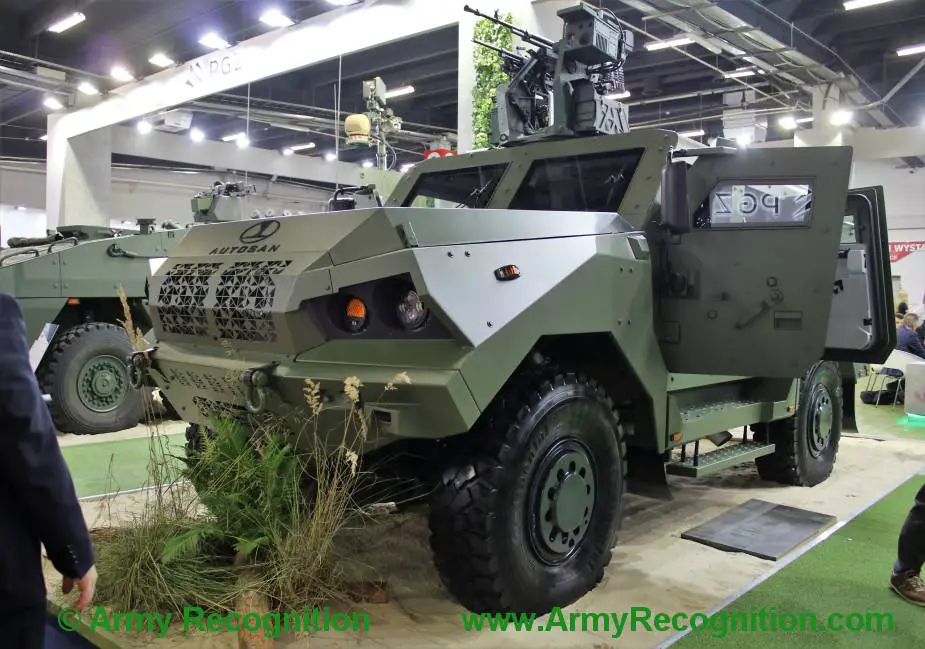Autosan S.A. is a Polish bus and coach manufacturer. The company is located in Sanok, Poland. Its sales network includes European (also non-EU countries), African and Asian countries. Currently, it produces approximately 300 buses a year. And now a first military vehicle appears in the tactical sector.

Autosan 4x4 multi-purpose tactical vehicle (Picture source: Army Recognition)
The chassis used for this vehicle is a Tatra 815-7 in a 4x4 version. Tatra 815-7 already serves in the Army of the Czech Republic and the Slovak Armed Forces. On the chassis of the Tatra 815-7 were built several armored transporters, such as the Czech Vega 4x4, the Egyptian Fahd 300, the French Nexter Titus, the Israeli Wildcat APC, the Jordanian Al-Wahash, the Nigerian Ara and the United Arab Emirates Legion. The basis of the structure is a central tube of approximately 40cm diameter. It consists in modules between which gears are mounted to transfer the force from the drive shafts located inside the tube to the oscillating half-shafts. This design does not require torque transmission through cardan joints. Gears and shafts are not exposed to damages caused by obstacles encountered while driving off-road. Such a chassis and transmission solution allows extension for longer vehicles, namely 6x6 or 8x8, all this with standard maintenance procedures and parts, which reduces the costs.
On the chassis is mounted an air-cooled Tatra T3C-928-90 turbocharged diesel engine developing 300 kW, or a liquid-cooled Cummins ISL turbocharged diesel engine developing 270 kW. The engine is coupled to a 6-speel Allison 4500SP automatic transmission. The vehicle can reach 110 km/h on road, with a cruising range of up to 700 km.
This 4x4 armored multi-purpose tactical vehicle can carry 8 people (commander, driver and 8 passengers). It weighs from 13 to 18 tons, a weight that depends on the protection level and the equipment chosen. The ballistic protection is STANAG 4569 level 2-4, while the mine protection is level 2a/2b – 3a/3b.
Autosan’s vehicle showcased at MSPO 2021 is equipped with a ZSMU-A5 remote-controlled weapon module whose armament is interchangeable: a WKM-Bm 12.7mm machine gun or a H&K (semi)automatic 40mm grenade launcher, with a coaxial UKM-2000C 7.62mm machine gun.
Autosan's history
The company was founded in 1832 by Walenty Lipiński and Mateusz Beksiński as a boilermaker's plant. The history of the factory changed depending on domestic and European economic situations. At the beginning of its activity, the factory produced devices and equipment for the oil mining, distillery and brewing industries. It later added transportation to its range and by 1894 it had become Poland's most important manufacturer of rail coaches and freight cars, tramcars and other high-capacity vehicles, while continuing to produce their initial output of boilers and other related devices. Later, even more variety of products was added, including cisterns, cranes, dredgers, road rollers, steel lifeboats, steel bridge constructions and casting articles.
In 1926, Autosan launched its first lot of buses mounted on Lancia chassis. Activities were interrupted during World War II but resumed in 1950. In 1973, a new family of buses is launched - the H9 bus, with the engine mounted at the rear. It would be followed in 1984 by the high-capacity H10 model.
In September 2013 the Court of Krosno declared the factory bankrupt. In a statement issued at the time it was explained that it was impossible to continue financing the restructuring. A few days later Sobiesław Zasada Group, which owned the company, sold a package of shares in Autosan to Gregory Tarnawa for one Polish zloty. Trade unionists from the factory picketed in front of the former owner, Sobiesław Zasada Group, in Kraków, demanding payment of arrears of salary for several months. The company is still operational.
Since 2001, the company has developed and produced components for rail vehicles, especially the bodies of railcars and trams. It appears now that it attempts to enter the military vehicle market.














